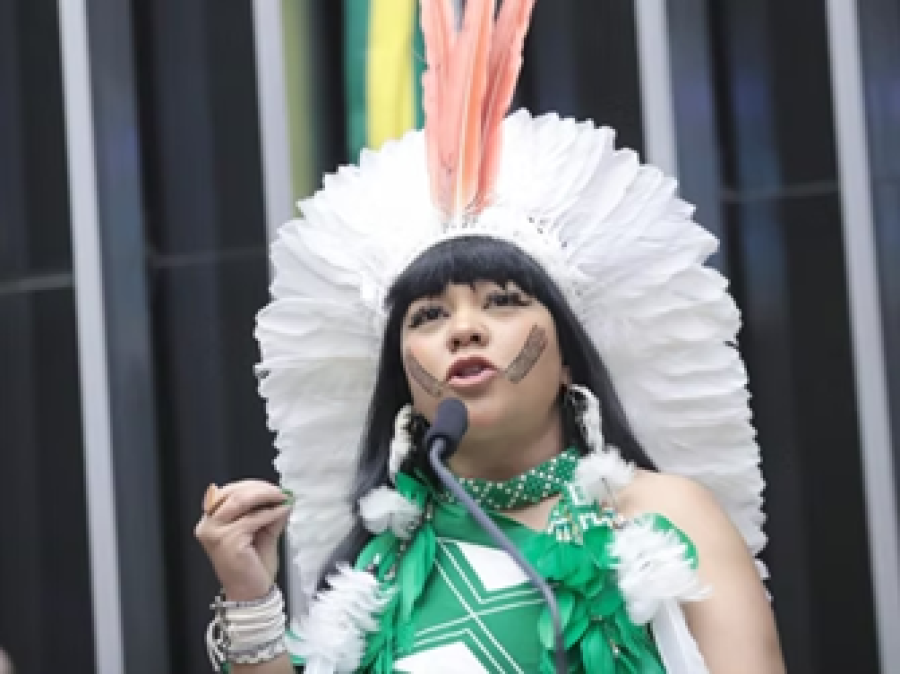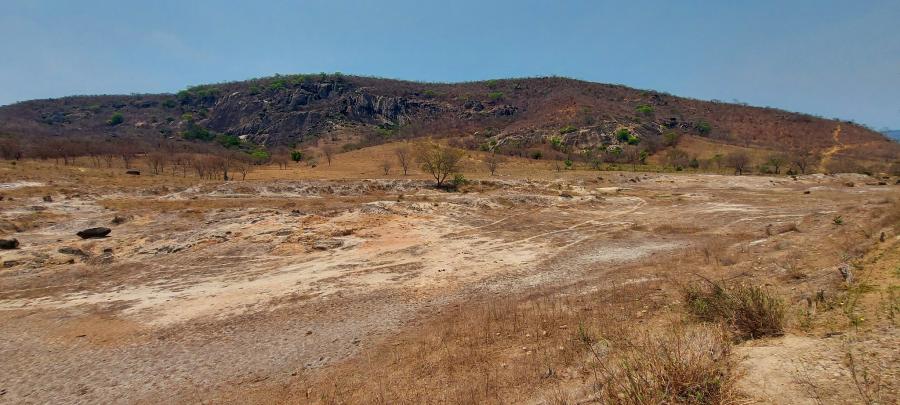Sunday evening, April 20, 1997, the Brazilian television network Rede Globo on its weekly program Fantástico, carried the tragic story of a Pataxó Indian of Bahia who had been brutally murdered. The Pataxó are the same indigenous people whom Pedro Alvares Cabral encountered in his "discovery" of Brazil in 1500. According to the news story, the 44 year old Pataxó leader, Gildino Jesus dos Santos, had gone to Brasilia with a number of his people to discuss their land claims with government officials, to participate in the demonstrations and festivities held in commemoration of Indian Day in Brazil, and to welcome thousands of landless poor, or Sem Terra, from all over Brazil-a historic moment in Brazilian struggles to institute agrarian reform. According to other Pataxós lodged in a FUNAI boarding house, Gildino came back late from the festivities and was barred entrance to the boarding house by military police. He wandered around the area for awhile and decided to sleep on a bus stop bench. An eyewitness report declared that a car with five youths approached, poured flammable liquid over the body of the sleeping Indian and set fire to him. It was later determined that the youths thought the Pataxó was another of the numerous mendingo or street beggars that wander the streets in all the major cities of Brazil. Every month at least one mendingo is killed in this fashion just for the "fun" of seeing the beggar run in panic and attempt to extinguish the fire before it completely burns him.
In the case of the Gildino dos Santos, 95% of his body was severely burned and he died the next day in the hospital where he had been taken by one of the few witnesses to the crime. Five youths between the ages of 16 and 19 years old were taken prisoner. All are from upper middle class families (one the son of a colonel, two others the sons of judges). The crime is punishable by a sentence of between 13 and 30 years of imprisonment. But will there be punishment? Certainly, the moment is propitious for an exemplary punishment since Brazilians are reeling from the recent shock of scenes of police brutality in Diadema, Sao Paulo, and Cidade de Deus, Rio de Janeiro. But, this threatens to be another horrible death statistic involving the Indians in Brazil.
When I was asked to prepare an article for this issue in commemoration of Cultural Survival's 25th anniversary -- for me an honor considering Cultural Survival has focused on Brazil from its beginning-I initially intended to write about the political victories and "conquests" by the Indigenous movement in Brazil, as demonstrated in an exemplary fashion by the Federation of Indigenous Organizations of the Rio Negro (FOIRN) in the Northwest Amazon. Victories which mark significant advances for the approximately 20,000 Indians of various linguistic families in the region, with the demarcation of a large and continuous land reserve and the participation of indigenous leadership in key positions of municipal government. I intended to focus on this area because it is where I have conducted anthropological and historical research since 1976 and I have been in contact with the Federation over the past 12 years since I returned to live in Brazil. A remarkable situation has changed from complete subordination and dependence on external agents of contact (the missionaries and military, principally) 20 years ago, to an effervescence of local indigenous political associations (over 20), coordinated by a region-wide indigenous confederation. Cultural traditions long suppressed by the missionaries to the point where indigenous people were "embarrassed" with their identity, have evolved in the form of a brilliant leader, Baniwa Gersen Luciano Santos, whose intellectual contribution to the indigenous movement in Amazonia in general will surely have long-term consequences.
The Northwest Amazon has become a critical testing ground in Brazil for important questions revolving around sustainable development and how these models are to be translated into practice. Are such models viable alternatives in the Northwest Amazon context, or is there still an enormous distance between NGOs and academic discourses about such models and the specific and immediate needs of native peoples? What are the effects of NGO involvement in local-level politics on Indian/white relations and the indigenous cultural revitalization movement in general in this area? The immediate problem, which the incident in Brasilia on Indian Day revealed in all its horror, is not the new models, but the old problems and the old wounds which have never had sufficient time to heal. Racism and impunity, the two principal villains, constantly tear away at the heart of victories. For those who have short memories and may have forgotten what these two villains have done in recent years, it may be well worth a quick review of other incidents and their outcomes.
Every year the Indigenous Missionary Council (CIMI, a branch of the Brazilian Catholic Church most directly involved in indigenous affairs) publishes a report on violence against the indigenous population in Brazil. The statistics show that not only is there an increase in violence year by year, but also in the kinds of aggression committed against indigenous peoples: murders of leaders, massacres, epidemic diseases caused by neglect of official health agencies, illegal detentions, and police brutality. One can only be shocked by the repeated acts of violence against Indians throughout the country. Yet how are these cases represented and reported in the national media and how are they dealt with by authorities? Are there patterns in the violence that characterize Indian/white relations?
Violence Against Indigenous People in Brazil
The most common pattern characterizing violence against indigenous people in Brazil is impunity Violence against the indigenous people in Brazil is horrible and lamentable, but it is ultimately beyond control. In case after case, the same scenario is revealed in which violent acts against Indians are never brought to justice. Conflicts and tensions, particularly over land and resource rights, build up over the years, and coupled with the inertia of FUNAI, explode in traumatic massacres or murders. Investigations are immediately initiated and the accused are apprehended; in this initial phase, international pressure has played an important role. The second phase includes a long period of procrastination which takes the steam out of the initial urgency of the case. Next, the accused stall for time to manipulate the proceedings while the investigations drag on. When, or if the case is finally brought to the courts, there is never sufficient evidence to incriminate the accused who are then absolved or given light sentences. The consequence of this scenario is the reproduction of violence in interethnic relations.
For example, a well-known Guaraní leader, Marçal Tupa-y, was murdered in 1983 by the hired gunmen of a local rancher that disputed the lands of Marçal's people. An entire decade passed before the perpetrator of the crime-known to everyone in the region-was brought to trial in a local court. In the end, the rancher was absolved of the crime for "lack of evidence." Another example is the 1988 massacre of Ticuna Indians of the upper Solimoes that left 14 dead, 23 wounded, and ten "disappeared." The massacre was perpetrated by 14 gunmen hired by a local lumber businessman in order to "settle" a land claim. This claim had dragged on for years because both federal authorities and local interests wished to suppress the movement. Despite the immediate national and international attention, today, nearly a decade later, news of the process has virtually disappeared from the press and the process of judicial procrastination has not gotten further than determining the jurisdiction for the trial-if there is to be one.
There is yet another scenario in which, through the manipulation of discourse about violence by the mass media, actual victims are transformed into perpetrators of violence against themselves or "blaming the victim," in which actual physical violence is compounded with symbolic violence against the victims. The case of the Yanomami in Brazil and Venezuela is certainly the most dramatic instance of this process.
In this case, structural amnesia and impunity have not been worse because the eyes of the world have focused on the Yanomami situation for so long. This has not immunized the Yanomami from physical violence (the 1993 massacre of 17 Yanomami of the village of Haximu), or from racist attacks such as those which characterized the articles published by Janer Cristaldo, an unknown journalist, in the Folha de Sao Paulo, two years ago. Cristaldo, in his initial article titled "Behind the Scenes of the Lano-Bluff," not only questioned the evidence of the massacre, but also systematically diverted the focus of the issue by claiming that numerous aggressions by indigenous peoples against the white man had never been brought to justice. Basing his characterization of the Yanomami on the "Fierce People" image popularized by Napoleon Chagnon, Cristaldo argued that Yanomami culture is itself "marked by violence" and that the international outrage over the Haxlmu massacre was nothing more than a conspiracy organized by anthropologists and indigenous defense organizations. He characterized the Yanomami as fodder for a supposed campaign to internationalize Amazonia "[e]ither the Armed Forces beware of this conspiracy by anthropologists," he warned, "or soon we will have the blue helmets [referring to UN intervention] in Amazonia." In this discourse, Brazilians are the victims while the Yanomami and their supporters are the aggressors.
"Sensationalizing" Violence
Numerous other cases could be analyzed to illustrate the kinds of structural violence that characterize Indian/white relations in Brazil today and the ways mass media has represented interethnic violence. In many cases, it is clear that media discourse serves the interests of local, regional and national power structures. It is also clear that the explanation of such violence is not sufficient to account for the incidents of brutality against individuals or whole groups of people. Indigenous peoples have shown that they are able to resist, adapt, and change, often in extraordinarily creative ways, to demands imposed on them from outside. Brazilian society, however, has repeatedly demonstrated that it is incapable of overcoming two of its deepest internal conflicts: racism and impunity Governments continue to demonstrate their inability to implement viable political and economic models that could enable ethnic and social minorities to co-exist and live in dignity in a plural society.
As always, on Indian Day in Brazil, a kind of macabre ritual takes place. The mass media talk about the "inevitable extinction" of indigenous peoples as if they ware disappearing species. Ecologists and anthropologists reaffirm the vitality of socio-diversity and the necessity of indigenous peoples for the future survival of the planet. Brazilian consciousness, in relation to Indians and minorities in general, needs to change, not the Indians who have shown that they are not merely "survivors" or "remnants" of a once great past, but fully capable of forging viable models for their future.
At noon on Monday, April 21st, Tiradentes Day (Tiradentes is a Brazilian national hero), Brasilia declared three days of mourning for the Pataxó Indian who died. A requiem for the old models of Brazilian society as well?
Article copyright Cultural Survival, Inc.



